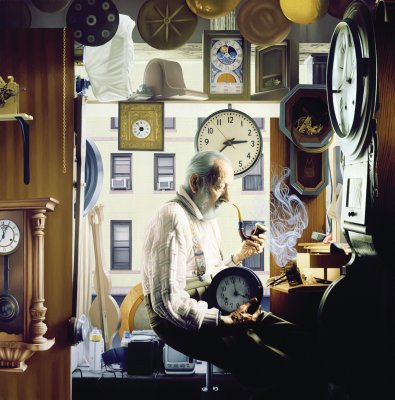Max Ferguson, narrative figurative painting

Max Ferguson learned the discipline for his meticulously rendered oil paintings while doing animated films as a teenager, graduating from New York University film school when he was 20. But it was while spending a year at an art school in Amsterdam that his interest switched to painting. He was, and continues to be, greatly influenced by Dutch 17th century genre painting. While in Amsterdam, after only painting a few months, the City of Amsterdam purchased one of his paintings. Back in New York a short time later, H.W. Janson, author of the classic text History of Art, also acquired one of his paintings.

He often paints older models. “While my fellow art students were painting nudes of young women, I was painting octogenarians with canes.”
He has worked on a number of series over the years, including the subways, Coney Island, nocturnal imagery. Most of his subject matter focuses on scenes of a rapidly disappearing New York. “It is not so much that I am nostalgically looking to the past, but looking to the future to preserve aspects of urban life for future generations that are quickly evaporating. Many of the images that I have painted are now either gone or renovated beyond recognition. It is both very gratifying to know that I captured them, at least in paint, but crushing to realize that they are now gone.”
Ferguson tends to shun fashion. As he puts it, “Today’s avante-garde is tomorrow’s pass. I am not a fashion designer from Milan, I am a painter from New York. It is not so much that I am consciously a contrarian, but it would seem that the louder and larger the work of my contemporaries grows, the quieter and smaller my paintings become.”
“My work is essentially autobiographical,” says Ferguson, with his two most frequent models being his father and himself. “The more personal you get, the more universal you become.”
“My paintings are generally populated by a solitary figure. In one sense it is a soliloquy. But there is someone else involved; the viewer. So it is more like a dialogue. It is that silent, emotional pas de deux between the two in which I am most interested.” “I am of course concerned with the technique and more cerebral aspects of painting, but more so with the emotional, psychological sides of the imagery. I try to think visually, but paint viscerally. Technique minus soul equals zero.”
His paintings are in many prominent private and public collections including the Metropolitan Museum of Art, The British Museum, and the Crystal Bridges Museum of American Art.
MAX FERGUSON: ON PAINTING
My preference is to work from life.
Unfortunately, with most of my subject matter, that is somewhere between impractical and impossible. I generally make photographic studies which I then use as reference material in my studio. These are merely a jumping-off point, and I often combine elements from many different photographic studies and modify them.
I then draw a number of studies until I have the final life-size cartoon.
While I approach every painting a little differently, I usually begin by transferring the lines of the drawing to the panel. I then do a rough, thin underpainting layer, using burnt umber, black, and white. After this, I paint one or two more layers of underpainting in color. Then I paint the final layer in color.
With each successive layer the painting becomes increasingly detailed and polished. While most of the decisions are made prior to beginning a painting, often changes are made in progress (note that the buttons on her pants are eliminated after the monochromatic underpainting).
I use sable brushes that are intended to be used for watercolors; it is the only way I can achieve the desired results.
The oil paintings generally take between two and four months to complete.
Max Ferguson
Jan 23, 2012
